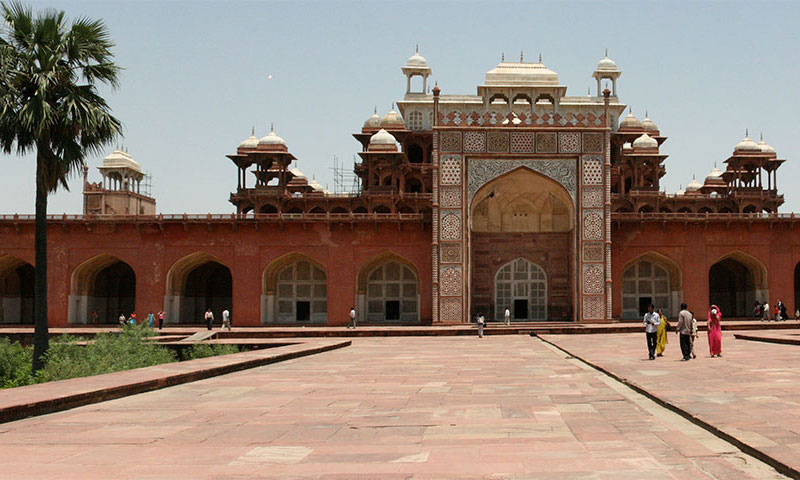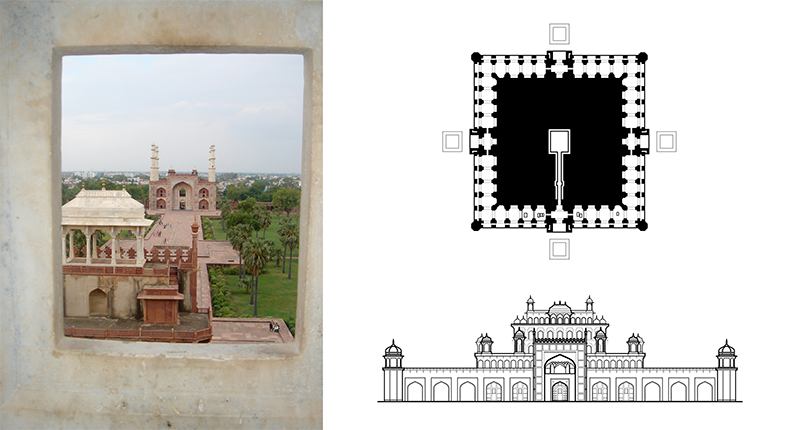|
Architectural style, structure, and tradition of the Mughal mausoleum built in 1613 |
||||
|
In the lineage of imperial Mughal mausoleums, none are as controversial as that of Akbar. The mausoleum was built in the suburbs of Agra at Sikandra by his son, Jahangir, and completed in 1613. Located on the Yamuna River near the Taj Mahal, Akbar’s Tomb is constructed out of red sandstone and white marble. The tomb has suffered loss of original full size etchings of building profiles and original symbols by craftsmen found on the pavement surrounding the monument. Documentation work is aimed at documenting the current state of the tomb interior and exterior and discovering the impact ongoing tourism is having on the site and its surrounding community. |
||||
|
Exploring building lineage |
||||
|
The structure and its surrounding complex are even larger than Humayun’s, and though some stylistic formalities such as the garden complex and the base of the mausoleum are similar to that of Humayun, the tiered structure above does not follow the same stylistic formalities and has no direct precedent in the Mughal funerary tradition. The more common Indo-Islamic building type of a centralized space for veneration capped by a large dome is discarded for a more traditional Indian palace building type similar to Akbar’s palace (Panch Mahal) at Fatehpur Sikri. The tomb consists of a tiered system of red sandstone galleries common to the traditional Indian methods of post and lintel construction. One of the most striking dissimilarities that scholars find puzzling is the fact that the building has no dome leaving the top story as an open courtyard, enclosed by a marble gallery. The emperor’s cenotaph is placed at the center of this marble gallery and opens to the sky, like that of Babur at Kabul. The square plan of Akbar’s tomb differs greatly from its immediate predecessor. The complex octagonal geometries common in the plans of earlier Islamic mausoleums are no longer present. The plan consists of a simple square punctuated by octagonal piers at each of the corners of the complex. A long narrow descending passageway leading to the mortuary chamber is closer in resemblance to the plans of ancient Egyptian pyramids than funerary monuments in the Indo-Islamic tradition. |
||||
|
Site photo and drafted building plan and elevation of the site (credit: DHARMA) |
||||
|
Examining details and materials |
||||
|
The differences present in the tombs of Humayun and Akbar are regulated to the overall composition of the buildings plans and elevations. In terms of material usage, decorative motifs and garden planning, Akbar’s mausoleum enhances the standards set at Humayun’s tomb. The juxtaposition of red-sandstone and white marble are refined by the use of stone intarsia that was not present at Humayun’s tomb. This method allowed for a greater variety of details and geometric motifs in the gateways surrounding the complex and the mausoleum. Glazed tiles are used on the chhatris located at the upper level of the building. The base of the structure that worked as the plinth of Humayun’s tomb is transformed at Akbar’s tomb into an arcade that allows for passage around the building. The main crypt is accessible through this base at the center of the building unlike at Humayun’s where access to the cenotaphs is made possible by ascension from the stairwell at the base of the platform to the main tomb structure. At the center of this arcaded first story is an iwan that projects high above the rest of the base, marking the center of the building. The iwan in this structure rises to a height that equals more than two times the height of the base of the overall building. Above the base of this mausoleum rises a four-tiered structure that does not follow the Timurid architectural tradition of the nine-part plan that was evident at Humayun’s tomb. The four upper stories are comprised of a columnar hall, and each of the flat roofs serves as a terrace for the hall above. The stories become progressively smaller, giving the building a pyramidal outline. The columns are of the Hindu architecture type with a partly octagonal shaft. In addition to conforming to the Islamic tradition of open air burial that is provided for on the top storey of Akbar’s tomb, this is the first Imperial Mughal tomb where minarets are introduced at the entrance of the complex. The minarets are later moved to the mausoleum platform at the tomb of Jahangir and get transformed in later examples. At the Taj Mahal, minarets were placed on the perimeter of the platform, where they were more aptly used as a framing element to the overall mausoleum rather than projecting elements utilized as an entry way.
|
||||
|
Examples of marble mosaic and screen details (credit: DHARMA) |
||||


 Objectives
Objectives 

